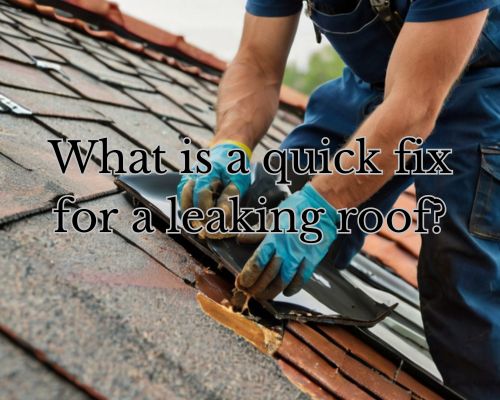Dealing with a roof leak can be stressful for any homeowner. A quick fix often involves using a combination of methods to mitigate the damage before a professional can address the issue comprehensively.
Roofing sealants or temporary patches can help prevent further water intrusion while planning for long-term repairs.

To address a leaky roof quickly, start by identifying the source of the leak.
Utilize a garden hose to simulate rainfall around the suspected areas and look for signs of water inside your home.
Once located, covering the leak with a waterproof tarp or applying roofing cement can provide immediate relief.
Remember, these quick fixes are not replacements for professional repairs, but they can safeguard your home and minimize damage in the meantime.
Simple actions taken promptly can make a significant difference until you’re ready to tackle a more permanent solution. Get to know how to address leakages with Charles Jimerson of CJ Commercial Roofing NJ.
Identifying and Assessing Roof Leaks
Detecting and assessing roof leaks is crucial for effective repairs. This process involves locating the source of the leak and evaluating any resulting damage. Understanding these steps will help you manage the situation more efficiently.
Locating the Source
Begin your inspection inside your home.
Use a flashlight to examine the attic for signs of moisture. Look for water stains, wet spots, or potential mold growth on the wood.
Pay special attention to areas around dormers, chimneys, and roof vents where leaks commonly occur.
Next, move to the exterior.
Examine the roof surface for damaged shingles, especially after storms. Check areas around skylights and any flashing that might be compromised.
Trace the path of any water or stains back to their origin, which may not always be directly above the observed damage.
Evaluating the Damage
Once you identify the source of the leak, assess the extent of the damage.
Look for rotted wood or areas where the roof decking may have been compromised. Signs of extensive water damage include warping and discoloration.
Additionally, check for mold or mildew in the affected areas.
These conditions can indicate prolonged exposure to moisture and may require professional remediation.
Record your observations to prioritize repairs based on the severity of the damage, focusing on areas that pose health risks or structural weaknesses.
Temporary and Permanent Repair Solutions
Addressing a leaking roof requires both immediate fixes and long-term strategies to prevent future issues. Understanding the difference between temporary measures and permanent repairs can help you maximize the effectiveness of your efforts while ensuring your home remains protected.
Immediate Temporary Fixes
For quick relief from a leak, you can implement temporary fixes that prevent further water damage.
Using a tarp is one effective method; lay it over the leak area, ensuring it extends a few feet beyond the edges. Secure it with roofing nails or weights to keep it in place.
Another option is employing roof sealant or caulk.
Apply it using a caulking gun to fill in any cracks or holes. This method works well for minor leaks. Ensure the surface is clean, and the weather is dry for optimal adhesion.
If shingles are damaged, consider using a utility knife to trim curled shingles or repair broken ones with roofing cement.
Always use a ladder safely and wear appropriate gear when accessing the roof.
These fixes serve as essential stopgaps until you can arrange a professional inspection.
Long-Term Repairs and Prevention
Long-term solutions involve more comprehensive repair work to ensure your roof remains intact.
Start by identifying and replacing damaged shingles. If you notice curled or broken shingles, carefully remove them using a pry bar and replace them with new ones. Ensure they are secured with screws or roofing nails.
Next, inspect flashing and vent boots around pipes and chimneys. These areas are prone to leaks due to improper installation or wear. Aluminum flashing can offer increased protection, as can a good patching technique using roofing cement.
Regular roof maintenance plays a key role in preventing future leaks.
Clean gutters to avoid overflow, and check for exposed fasteners or nails that may become problematic.
A roofing contractor like CJ Commercial Roofing NJ, can help assess long-term needs and assist with repairs. Regular inspections can help catch potential issues early and maintain the integrity of your roofing system.